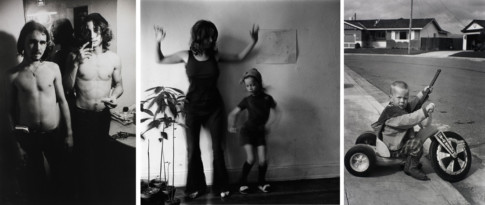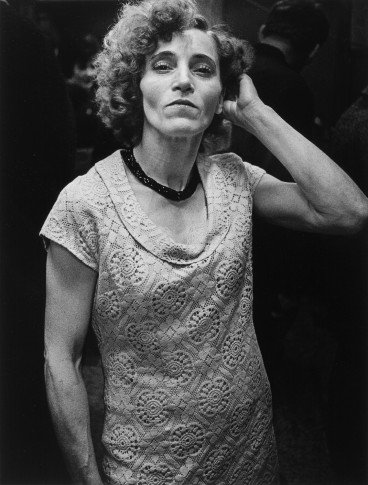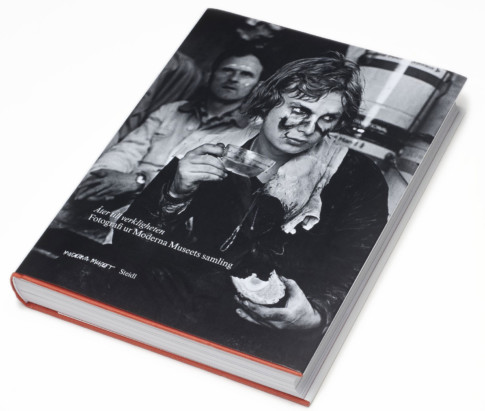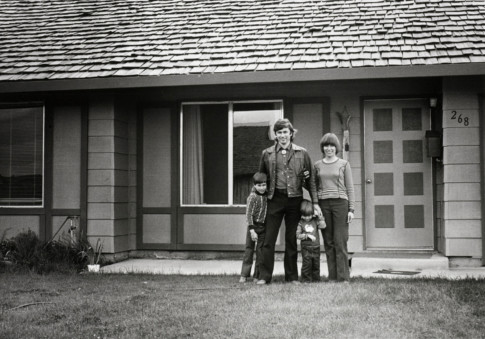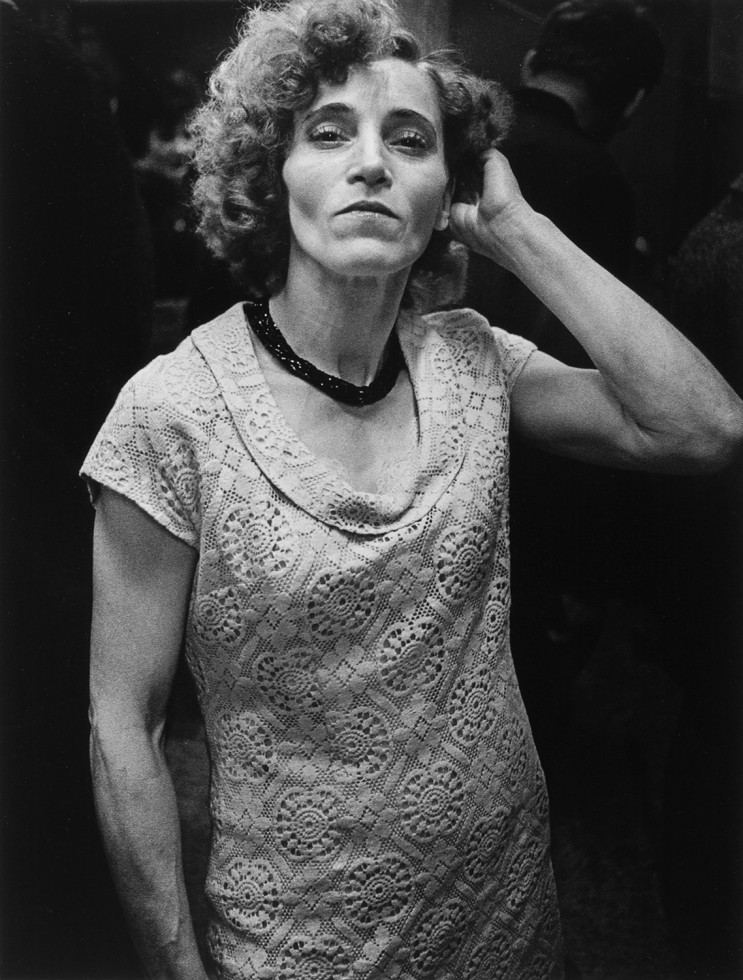
Anders Petersen, Marlene. From the series Café Lehmitz, 1967-70/1986 © Anders Petersen
Reality Revisited
Text: Anna Tellgren, Curator
They have used the medium in various ways to develop their own expressive style through the photographic image. Postwar street photography and subjective photography were seminal to the photographers whose careers began in the 1960s and peaked in the 1970s before the breakthrough of postmodern photo-based art in the early 1980s. The title, Reality Revisited, refers to the way these photographers frequently used, or returned to, their own reality as a starting point. Many of them sought new ways of documenting real life – others looked for possibilities to create photographs that went beyond the everyday. A development can be seen during this period, where the 1960s and early 1970s are dominated by distinctly documentary projects. Gradually throughout the 1970s and early 1980s the subjective, surrealistically inspired or body-oriented subjects appear. This retrospective exhibition also allows us to rediscover the traditional, analogue photographic image that has been the dominant technique up until the early 2000s, and which is something entirely different than the digitally processed, often enacted, large colour photographs that are created by many photographers today. However, we can also see that many of the issues that photographers were dealing with in the 1970s continue to preoccupy today’s practitioners: issues relating to form and content, subjectivity and objectivity, art and politics.
“Documentary” photography was a key concept during this period. The term was frequently debated and is used even today to describe works by these photographers. Documentary photography has a long history, with roots in 1890s USA and experienced a golden age in the 1930s, with the famous American project Farm Security Administration (FSA). The genre name was culled from film and came into regular use in the late 1920s to signify a certain type of photography. The basic precept of the genre is a belief that photography can document and reveal hidden social injustices. There are many different interpretations of the concept, and in recent years the genre has been reconsidered and criticised, especially by the photographers themselves and by other artists and theoreticians, who point out, for instance, that people who were not in a position to represent themselves were exploited, and thus objectified. The documentary practice was also based on the presumed immediacy and truthfulness of the photograph. In the 1970s, the relationship between art and truth was increasingly focused upon both by photographers and those who studied their pictures, which led to a gradual change and development in the documentary genre.
The exhibition presents major portfolios of works by the photographers Larry Clark, Ann Christine Eek, Ralph Gibson, Paul Hill, Walter Hirsch, Kenneth Josephson, Chris Killip, Eva Klasson, Duane Michals, Bill Owens, Hasse Persson, Anders Petersen, Milton Rogovin, Melissa Shook, Antanas Sutkus and Arthur Tress. Other photographers are represented with a smaller number of works. In addition, a small selection of photographs by influential photo-historic pioneers will be included. Interestingly, many of these forerunners were still active in the 1970s and were practising alongside the photographers who saw their breakthrough at the time and later took over the photo scene.
American photography entered into an expansive phase during this period, winning a massive and enthusiastic audience. The field was gradually being institutionalised in the USA, and many curators, gallery owners, editors and critics started dealing more professionally with photography. Europe went through a similar development. John Szarkowski, the influential director of the photography department at the Museum of Modern Art in New York between 1962 and 1991, produced exhibitions featuring Diane Arbus, Robert Frank, Lee Friedlander and William Eggleston and other photographers who were to have a strong impact on many younger photographers and on the definition of the aesthetic potential of the medium. Reality Revisited spans from Larry Clark’s incisive, naked and controversial photographs of his drug-abusing friends in his home town of Tulsa, via Bill Owens’ humorous and challenging documentations of the perfect American suburban lifestyle and Milton Rogovin’s portraits of the inhabitants of Lower West Side, Buffalo, to Kenneth Josephson’s emblematic “Images within Images”, which reflect on representation and veracity in the photographic act. Others who emerged at this time are Ralph Gibson, with his dark, surrealist images focusing on eroticism and mysticism. He also made a substantial contribution by publishing numerous photography books. A similar surrealist theme is also found in Arthur Tress’ imagery, with its eccentric characters and absurd settings. Duane Michals’ influence on the idea of using the camera for a more conceptual creation of image should not be underestimated. In his visual narratives, he explores the intangible dimension of human existence, and his photographs often have hand-written, poetic texts about death, dreams, sexuality and the cosmos. Photography became an increasingly natural element in art from the 1960s and onwards. Andy Warhol is one artist who based many of his works on photographs and used polaroids and pictures from photo booths. His photographs were rarely arranged, but simply recorded everyday things and settings with a snapshot aesthetics. The photo album in two volumes that Andy Warhol donated to the Moderna Museet collection in 1968 contains several hundred black-and-white photographs from his life at the Factory, including pictures by the photographers Billy Name and Stephen Shore. Swedish artists in a similar vein are Carl Johan De Geer, with his lively fashion photographs and his project Med kameran som tröst (The Camera as Comforter, 1979), and Otmar Thormann, who portrays dogs with their more or less eccentric owners, and perhaps also Walter Hirsch, for the method with which he produced the series ”London -67 den 13 april kl 09.00 till 23.00 1967”.
In other words, the extensive Moderna Museet collection of photography includes many of the most distinguished photographers of the period. The strength of our collection of American and Swedish photography from the 1970s has a historical explanation. In 1971, Fotografiska Museet (FM) was established as a separate department within Moderna Museet. For the first time there was a body that could organise regular exhibitions of photographic images. Up until 1998, FM continued to operate as an independent department at Moderna Museet, but when the museum was reorganised and moved into the new building, the Collection of photography was incorporated with the museum collection. The name “Fotografiska Museet” was abolished. In its first two decades of existence, FM produced four or five exhibitions per year of historic or contemporary photography. A few examples of exhibitions that were especially significant for the museum and the collection are Ralph Gibson (1976–77), Duane Michals (1980), Helen Levitt (1985) and Larry Clark (1986). The curator, Leif Wigh, made several visits to the USA in the mid-1970s, leading to crucial encounters with key photographers, and eventually to exhibitions and acquisitions. For instance, the collection acquired the portfolio American Roads in 1982, with 20 photographs by as many photographers who pursued the tradition from Walker Evans, documenting the American landscape and countryside with empathy and feeling.
Women photographers have had a prominent position in Moderna Museet’s exhibitions historically. In 1981, for instance, the museum featured Se dig om i glädje. Sex fotografer – sex temperament (Look Back in Joy – Six Photographers, Six Temperaments) with six women photographers, including Swedish-born Birgitta Ralston with her series Masks (1974–77). She was one of many students of Minor White and was deeply inspired by his teaching and theories on photography. American Melissa Shook was also featured as an exponent of new American 1970s photography. Her work focuses on personal themes, such as her own situation, her body, the family, and especially her daughter Krissy. In connection with the exhibition in 1981, she donated a large portfolio of her diary photographs to the Moderna Museet collection. Eva Klasson had a brief and acclaimed career in Paris in the mid-1970s, with a series of intimate close-ups of her body, which she compiled in an artist’s book with the title Le troisième angle (1976). The 2009 exhibition also features works by Judy Dater, Ann Christine Eek, Monica Englund, Gretchen Garner, Nan Goldin, Denise Grünstein, Irina Ionesco, Graciela Iturbide and Lilo Raymond. Thus, the focus is on American and Swedish photography, with a few examples of Nordic and Baltic photography. The proximity to Eastern Europe and the Baltic nations means that the Moderna Museet Collection of photography has an interesting selection of works from these regions. We will, for instance, include Antanas Sutkus’ powerful documentations from his native Lithuania and Reine Välme’s photographs from communist parades in Estonia. The exhibition reveals a tension between East and West, between Eastern Europe and the USA.
The background to the tendencies that developed in the 1970s can be sought in the humanistic photography that found its subject in documenting mankind and his footprints. the style developed from the 1920s up to the early 1960s. The illustrated magazines Life, Look, Picture Post, Paris Match and Swedish Se (Look)contributed to the growing demand for photographs of exotic places and current affairs. When the national borders reopened after the Second World War, photographers were again able to travel with their cameras. Cities like Berlin, Paris, London and New York became forums where many of the most famous photographers in history, Bill Brandt, Brassaï, Henri Cartier-Bresson, André Kertész and Paul Strand, worked creatively and tried out new ideas in photography. The young photographers read the illustrated magazines, studied photography books and, if they could, travelled to learn and work. One of the climaxes of this genre was the large and immensely popular exhibition The Family of Man (1955) at the Museum of Modern Art. The heroes of the day also included the celebrated fashion photographers whose pictures appeared in extravagant fashion features in prestigious fashion magazines. William Klein, Helmut Newton and Irving Penn are among those whose respective styles and work methods were an inspiration to many younger photographers, for instance, Lennart Durehed, who was an assistant to Penn for some years and was impressed by his work ethics and later developed a photographic style of his own that focuses on surfaces, spaces and architecture. The humanist movement eventually came to be perceived as sentimental, and when the political situation changed in connection with the Vietnam War and other conflicts, photographers began to take a stand in a different way. This is demonstrated in British photographer Chris Killip’s fascinating portraits of people’s everyday lives in the UK, and his fellow Brit Paul Hill’s personal landscapes. We find the same social commitment in Swedish Hasse Persson’s extensive reportage from the USA, documenting freedom marches, war veterans, gay power, presidential election campaigns and the people who lived in the midst of these events.
As in many other artistic fields, Sweden was slightly behind developments internationally. After 1968, many Swedish photographers showed a greater political awareness in their work and documentary photography was strong, not to say dogmatic. New organisations were formed, like Fotograficentrum, which operated alongside the established institutions, collecting, selling and exhibiting photography. Typical documentary photographers of the time were Hans Alenius, Yngve Baum, Jens S Jensen, Björn Myrman and Odd Uhrbom. Ann Christine Eek’s in-depth reportage from Yugoslavia is also an example of this approach. The activities of Fotografiska Museet was harshly criticised at the time for its overly aesthetic approach to photography, with too much emphasis on art photography, while documentary photography was insufficiently represented. This debate reached its peak in connection with the exhibition Bländande Bilder (Dazzling Pictures, 1981) with a long essay by Leif Wigh in the catalogue on the theme of realism.
Christer Strömholm is a prominent Swedish photographer who came to photography via graphic art in the 1940s. During his sojourns in Paris in the 1950s and 60s he developed a style similar to street photography, and it was at this time he produced his famous portraits of transsexuals at Place Blanche. He undertook several photographic journeys in the first half of the 1960s, visiting both Japan and the USA. He also began teaching photography at Kursverksamheten in Stockholm early in his career. This eventually evolved into the legendary Fotoskolan, from which some 1,200 students graduated between 1962 and 1974. Its curriculum was based largely on the methods of the German MD, photographer and pedagogue Otto Steinert, who emphasised the artistic, personal and subjective creativity of the students, along with photographic craftsmanship. In the 1950s, he produced three major exhibitions under the collective heading of Subjektive Fotografie. His many adepts include the Swedes Christer Strömholm and Jan Fridlund. Christer Strömholm’s photographs and methods have inspired generations of Swedish photographers, and consequently, the subjective movement has long been a dominant undercurrent in Swedish photography. This exhibition features several of Strömholm’s student and friends, including Dawid, Kenneth Gustavsson, Walter Hirsch, Gerry Johansson, Eva Klasson, Anders Petersen and Gunnar Smoliansky. Anders Petersen is possibly the one who has most clearly continued in Strömholm’s spirit, and we present the part of his oeuvre that was his breakthrough, his series of photographs from Café Lehmitz in Hamburg, also published as a book in 1978.
The Moderna Museet Collection of photography contains some of the best works of all these photographers, and it is a privilege to work with them and to present this photographic treasure.

